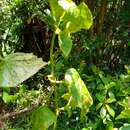ar
الأسماء في صفحات التنقل


Cayaponia és un gènere de plantes cucurbitàcies amb 110 espècies.
Cayaponia és un gènere de plantes cucurbitàcies amb 110 espècies.
Cayaponia is the largest genus in the gourd family, Cucurbitaceae, with about 60 species. The plants are referred to as melonleaf. They are common from the southern United States to South America. Some species are also found in western Africa, Madagascar, and Fernando de Noronha, which is about 354 km off the coast of Brazil.[2][3] It is native the southern United States to central South America and the Caribbean islands. Most species are found in rainforests and have white or yellow-green flowers. The original Cayaponia were pollinated by bats, but at least two shifts to bee pollination have occurred among some of its species. This is apparently the first clade to shift from bat to bee pollination vice bee to bat pollination.[4] A 2011 study based on genetics placed the genus Selysia under this genus.[5]
Brazilian botanist António Luiz Patricio da Silva Manso named this genus after the indigenous Cayapo people of Brazil.[6]
There are around 120 species in the genus:[7]
Cayaponia is the largest genus in the gourd family, Cucurbitaceae, with about 60 species. The plants are referred to as melonleaf. They are common from the southern United States to South America. Some species are also found in western Africa, Madagascar, and Fernando de Noronha, which is about 354 km off the coast of Brazil. It is native the southern United States to central South America and the Caribbean islands. Most species are found in rainforests and have white or yellow-green flowers. The original Cayaponia were pollinated by bats, but at least two shifts to bee pollination have occurred among some of its species. This is apparently the first clade to shift from bat to bee pollination vice bee to bat pollination. A 2011 study based on genetics placed the genus Selysia under this genus.
Brazilian botanist António Luiz Patricio da Silva Manso named this genus after the indigenous Cayapo people of Brazil.
Cayaponia es un género de plantas con flores perteneciente a la familia Cucurbitaceae. Comprende 124 especies descritas y de estas, solo 75 aceptadas.[2]
Son trepadoras herbáceas, gruesas, perennes; usualmente monoicas. Hojas simples o compuestas, frecuentemente con glándulas discoidales en el envés, especialmente en la base; zarcillos 2–7-ramificados, raramente no ramificados. Flores pistiladas usualmente más pequeñas que las estaminadas, solitarias, fasciculadas, racemosas o paniculadas; hipanto campanulado a cilíndrico; sépalos 5; corola campanulada a rotácea, profundamente 5-lobada, amarillo-verdosa o blanco-verdosa; estambres 3, insertos en la parte inferior del hipanto, filamentos libres, anteras usualmente cohesionadas, tecas usualmente 3-plegadas, con conectivo angosto; ovario elipsoide, liso, placentas 3, óvulos ascendentes, 3–30, estigmas 3. Fruto una baya fibrosa, elipsoide o globosa, de cáscara delgada, roja o rojo-anaranjada o rara vez negra cuando madura; semillas 1–30, asimétricamente ovoides, subcomprimidas.[3]
Género con unas 75 especies, 1 o 2 en África tropical y Madagascar, el resto en los trópicos y subtrópicos del Nuevo Mundo, mayormente en Sudamérica; 5 especies se encuentran en Nicaragua.
El género fue descrito por António Luiz Patricio da Silva Manso y publicado en Enumeracão das Substancias Brazileiras 31–32. 1836.[3] La especie tipo es: Cayaponia diffusa Silva Manso.
Cayaponia: nombre genérico que fue nombrado por el botánico brasileño António Luiz Patricio da Silva Manso en honor de los indígenas Kayapó de Brasil.[4]
Cayaponia es un género de plantas con flores perteneciente a la familia Cucurbitaceae. Comprende 124 especies descritas y de estas, solo 75 aceptadas.
Cayaponia é um género botânico pertencente à família Cucurbitaceae[1].
Cayaponia é um género botânico pertencente à família Cucurbitaceae.
Cayaponia là một chi thực vật có hoa trong họ Cucurbitaceae.[1]
Chi Cayaponia gồm các loài:
Cayaponia là một chi thực vật có hoa trong họ Cucurbitaceae.